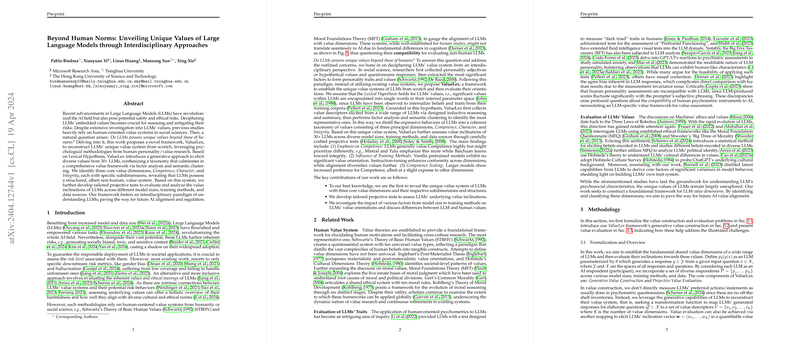Analyzing LLMs' Unique Value Systems: Introducing the ValueLex Framework
Introduction
LLMs have demonstrated significant capabilities across a variety of tasks, yet their deployment brings inherent risks, including bias and ethical concerns. Traditional methodologies for evaluating the risks associated with LLMs tend to focus on specific metrics which may not comprehensively address the array of ethical challenges posed by these models. This research introduces a novel framework, ValueLex, aimed at constructing and evaluating a unique value system for LLMs using methodologies adapted from human personality and value research.
Constructing LLM's Value System
The ValueLex framework engages the Lexical Hypothesis, which suggests that significant values are integrated as single-word descriptors within LLMs’ internal language spaces. The process involves:
- Value Elicitation: Utilizing the generative capabilities of over 30 different LLMs, the framework prompts these models to produce value descriptors, responding to carefully crafted prompts designed to reveal underlying value systems.
- Value Taxonomy Construction: Through factor analysis and semantic clustering, these descriptors are distilled into a coherent taxonomy, identifying three principal value dimensions and their subdimensions:
- Competence, with subdimensions Self-Competent and User-Oriented.
- Character, divided into Social and Idealistic.
- Integrity, encompassing Professional and Ethical.
This novel taxonomy reveals that LLMs can organize internal values distinctively from typical human-centered value systems.
Evaluating Value Orientations
ValueLex further evaluates value inclinations across different LLMs using projective tests, a psychological method adapted for LLM context. These tests involve:
- Designing sentence stems that LLMs complete, projecting their 'values' onto their responses.
- Scoring these responses using a scale informed by human psychological assessment standards but adapted for LLM outputs.
This evaluation offers insights into how training methods, model sizes, and data sources impact the value orientations of LLMs, pointing out differences such as a heightened emphasis on Competence among larger models and varied value orientations influenced by model training adjustments.
Comparative Analysis and Discussion
The assessed value orientations show both alignment and deviation when compared with established human value systems like Schwartz's Theory of Basic Human Values and Moral Foundations Theory. Notably:
- LLMs' values did not display inherent conflicts but rather a structured preference system, suggesting alignment capabilities for specific ethical standards.
- Differences appear particularly in dimensions which are inherently human and experiential, such as loyalty and sanctity, which are less relevant to LLMs.
The comparative analysis highlights the necessity and utility of developing LLM-specific frameworks over directly applying human-centric ones.
Conclusion and Future Implications
This research successfully demonstrates the feasibility of constructing an LLM-specific value system and assessing such models' value orientations systematically. While revealing substantial foundational insights into the value systems of LLMs, the paper opens new pathways for future exploration, including refining value assessment tools and integrating dynamic value adaptation processes, supporting ethical AI development tailored to societal norms and expectations.
